Kazuya Yoshida
Towards the Automation in the Space Station: Feasibility Study and Ground Tests of a Multi-Limbed Intra-Vehicular Robot
Dec 29, 2025Abstract:This paper presents a feasibility study, including simulations and prototype tests, on the autonomous operation of a multi-limbed intra-vehicular robot (mobile manipulator), shortly MLIVR, designed to assist astronauts with logistical tasks on the International Space Station (ISS). Astronauts spend significant time on tasks such as preparation, close-out, and the collection and transportation of goods, reducing the time available for critical mission activities. Our study explores the potential for a mobile manipulator to support these operations, emphasizing the need for autonomous functionality to minimize crew and ground operator effort while enabling real-time task execution. We focused on the robot's transportation capabilities, simulating its motion planning in 3D space. The actual motion execution was tested with a prototype on a 2D table to mimic a microgravity environment. The results demonstrate the feasibility of performing these tasks with minimal human intervention, offering a promising solution to enhance operational efficiency on the ISS.
A Sequential Hermaphrodite Coupling Mechanism for Lattice-based Modular Robots
Dec 29, 2025Abstract:Lattice-based modular robot systems are envisioned for large-scale construction in extreme environments, such as space. Coupling mechanisms for heterogeneous structural modules should meet all of the following requirements: single-sided coupling and decoupling, flat surfaces when uncoupled, and coupling to passive coupling interfaces as well as coupling behavior between coupling mechanisms. The design requirements for such a coupling mechanism are complex. We propose a novel shape-matching mechanical coupling mechanism that satisfies these design requirements. This mechanism enables controlled, sequential transitions between male and female states. When uncoupled, all mechanisms are in the female state. To enable single-sided coupling, one side of the mechanisms switches to the male state during the coupling process. Single-sided decoupling is possible not only from the male side but also from the female side by forcibly switching the opposite mechanism's male state to the female state. This coupling mechanism can be applied to various modular robot systems and robot arm tool changers.
Optimal Trajectory Planning for Orbital Robot Rendezvous and Docking
Dec 26, 2025Abstract:Approaching a tumbling target safely is a critical challenge in space debris removal missions utilizing robotic manipulators onboard servicing satellites. In this work, we propose a trajectory planning method based on nonlinear optimization for a close-range rendezvous to bring a free-floating, rotating debris object in a two-dimensional plane into the manipulator's workspace, as a preliminary step for its capture. The proposed method introduces a dynamic keep-out sphere that adapts depending on the approach conditions, allowing for closer and safer access to the target. Furthermore, a control strategy is developed to reproduce the optimized trajectory using discrete ON/OFF thrusters, considering practical implementation constraints.
MoonBot: Modular and On-Demand Reconfigurable Robot Toward Moon Base Construction
Dec 26, 2025Abstract:The allure of lunar surface exploration and development has recently captured widespread global attention. Robots have proved to be indispensable for exploring uncharted terrains, uncovering and leveraging local resources, and facilitating the construction of future human habitats. In this article, we introduce the modular and on-demand reconfigurable robot (MoonBot), a modular and reconfigurable robotic system engineered to maximize functionality while operating within the stringent mass constraints of lunar payloads and adapting to varying environmental conditions and task requirements. This article details the design and development of MoonBot and presents a preliminary field demonstration that validates the proof of concept through the execution of milestone tasks simulating the establishment of lunar infrastructure. These tasks include essential civil engineering operations, infrastructural component transportation and deployment, and assistive operations with inflatable modules. Furthermore, we systematically summarize the lessons learned during testing, focusing on the connector design and providing valuable insights for the advancement of modular robotic systems in future lunar missions.
Online Inertia Parameter Estimation for Unknown Objects Grasped by a Manipulator Towards Space Applications
Dec 26, 2025Abstract:Knowing the inertia parameters of a grasped object is crucial for dynamics-aware manipulation, especially in space robotics with free-floating bases. This work addresses the problem of estimating the inertia parameters of an unknown target object during manipulation. We apply and extend an existing online identification method by incorporating momentum conservation, enabling its use for the floating-base robots. The proposed method is validated through numerical simulations, and the estimated parameters are compared with ground-truth values. Results demonstrate accurate identification in the scenarios, highlighting the method's applicability to on-orbit servicing and other space missions.
3D Mapping Using a Lightweight and Low-Power Monocular Camera Embedded inside a Gripper of Limbed Climbing Robots
Nov 08, 2025Abstract:Limbed climbing robots are designed to explore challenging vertical walls, such as the skylights of the Moon and Mars. In such robots, the primary role of a hand-eye camera is to accurately estimate 3D positions of graspable points (i.e., convex terrain surfaces) thanks to its close-up views. While conventional climbing robots often employ RGB-D cameras as hand-eye cameras to facilitate straightforward 3D terrain mapping and graspable point detection, RGB-D cameras are large and consume considerable power. This work presents a 3D terrain mapping system designed for space exploration using limbed climbing robots equipped with a monocular hand-eye camera. Compared to RGB-D cameras, monocular cameras are more lightweight, compact structures, and have lower power consumption. Although monocular SLAM can be used to construct 3D maps, it suffers from scale ambiguity. To address this limitation, we propose a SLAM method that fuses monocular visual constraints with limb forward kinematics. The proposed method jointly estimates time-series gripper poses and the global metric scale of the 3D map based on factor graph optimization. We validate the proposed framework through both physics-based simulations and real-world experiments. The results demonstrate that our framework constructs a metrically scaled 3D terrain map in real-time and enables autonomous grasping of convex terrain surfaces using a monocular hand-eye camera, without relying on RGB-D cameras. Our method contributes to scalable and energy-efficient perception for future space missions involving limbed climbing robots. See the video summary here: https://youtu.be/fMBrrVNKJfc
Multi-Modal Decentralized Reinforcement Learning for Modular Reconfigurable Lunar Robots
Oct 23, 2025Abstract:Modular reconfigurable robots suit task-specific space operations, but the combinatorial growth of morphologies hinders unified control. We propose a decentralized reinforcement learning (Dec-RL) scheme where each module learns its own policy: wheel modules use Soft Actor-Critic (SAC) for locomotion and 7-DoF limbs use Proximal Policy Optimization (PPO) for steering and manipulation, enabling zero-shot generalization to unseen configurations. In simulation, the steering policy achieved a mean absolute error of 3.63{\deg} between desired and induced angles; the manipulation policy plateaued at 84.6 % success on a target-offset criterion; and the wheel policy cut average motor torque by 95.4 % relative to baseline while maintaining 99.6 % success. Lunar-analogue field tests validated zero-shot integration for autonomous locomotion, steering, and preliminary alignment for reconfiguration. The system transitioned smoothly among synchronous, parallel, and sequential modes for Policy Execution, without idle states or control conflicts, indicating a scalable, reusable, and robust approach for modular lunar robots.
Tightly-Coupled LiDAR-IMU-Leg Odometry with Online Learned Leg Kinematics Incorporating Foot Tactile Information
Jun 11, 2025Abstract:In this letter, we present tightly coupled LiDAR-IMU-leg odometry, which is robust to challenging conditions such as featureless environments and deformable terrains. We developed an online learning-based leg kinematics model named the neural leg kinematics model, which incorporates tactile information (foot reaction force) to implicitly express the nonlinear dynamics between robot feet and the ground. Online training of this model enhances its adaptability to weight load changes of a robot (e.g., assuming delivery or transportation tasks) and terrain conditions. According to the \textit{neural adaptive leg odometry factor} and online uncertainty estimation of the leg kinematics model-based motion predictions, we jointly solve online training of this kinematics model and odometry estimation on a unified factor graph to retain the consistency of both. The proposed method was verified through real experiments using a quadruped robot in two challenging situations: 1) a sandy beach, representing an extremely featureless area with a deformable terrain, and 2) a campus, including multiple featureless areas and terrain types of asphalt, gravel (deformable terrain), and grass. Experimental results showed that our odometry estimation incorporating the \textit{neural leg kinematics model} outperforms state-of-the-art works. Our project page is available for further details: https://takuokawara.github.io/RAL2025_project_page/
Soft Gripping System for Space Exploration Legged Robots
Nov 08, 2024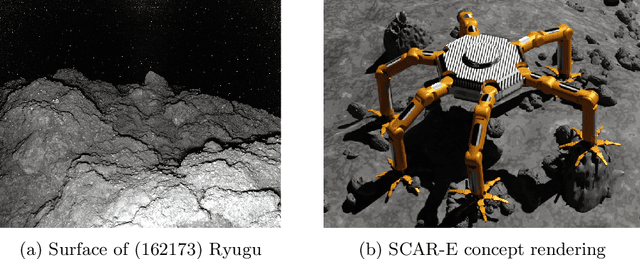
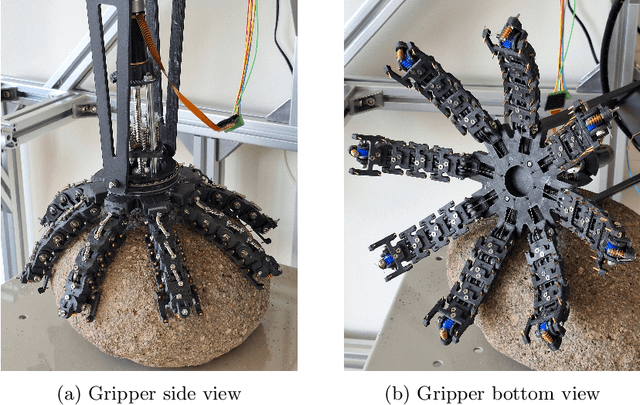
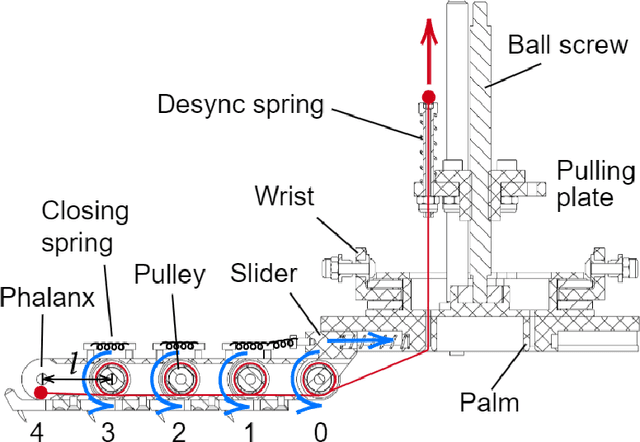
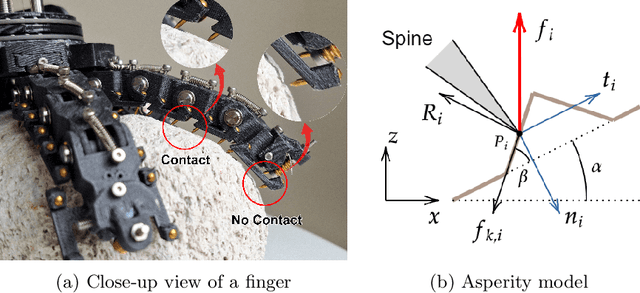
Abstract:Although wheeled robots have been predominant for planetary exploration, their geometry limits their capabilities when traveling over steep slopes, through rocky terrains, and in microgravity. Legged robots equipped with grippers are a viable alternative to overcome these obstacles. This paper proposes a gripping system that can provide legged space-explorer robots a reliable anchor on uneven rocky terrain. This gripper provides the benefits of soft gripping technology by using segmented tendon-driven fingers to adapt to the target shape, and creates a strong adhesion to rocky surfaces with the help of microspines. The gripping performances are showcased, and multiple experiments demonstrate the impact of the pulling angle, target shape, spine configuration, and actuation power on the performances. The results show that the proposed gripper can be a suitable solution for advanced space exploration, including climbing, lunar caves, or exploration of the surface of asteroids.
Sinkage Study in Granular Material for Space Exploration Legged Robot Gripper
Nov 08, 2024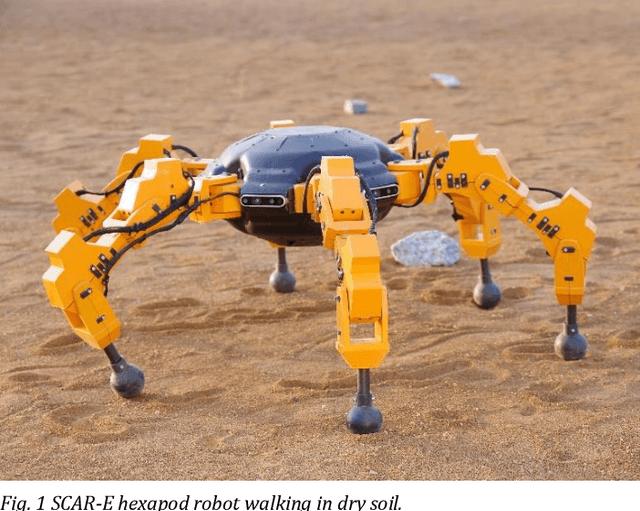
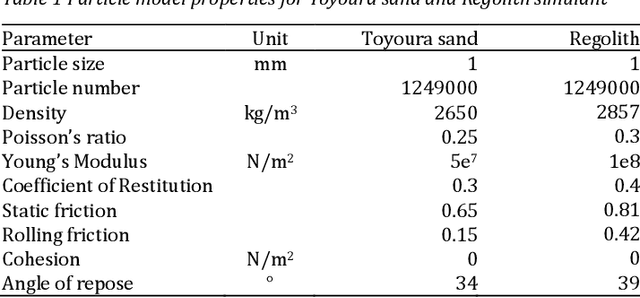


Abstract:Wheeled rovers have been the primary choice for lunar exploration due to their speed and efficiency. However, deeper areas, such as lunar caves and craters, require the mobility of legged robots. To do so, appropriate end effectors must be designed to enable climbing and walking on the granular surface of the Moon. This paper investigates the behavior of an underactuated soft gripper on deformable granular material when a legged robot is walking in soft soil. A modular test bench and a simulation model were developed to observe the gripper sinkage behavior under load. The gripper uses tendon-driven fingers to match its target shape and grasp on the target surface using multiple micro-spines. The sinkage of the gripper in silica sand was measured by comparing the axial displacement of the gripper with the nominal load of the robot mass. Multiple experiments were performed to observe the sinkage of the gripper over a range of slope angles. A simulation model accounting for the degrees of compliance of the gripper fingers was created using Altair MotionSolve software and coupled to Altair EDEM to compute the gripper interaction with particles utilizing the discrete element method. After validation of the model, complementary simulations using Lunar gravity and a regolith particle model were performed. The results show that a satisfactory gripper model with accurate freedom of motion can be created in simulation using the Altair simulation packages and expected sinkage under load in a particle-filled environment can be estimated using this model. By computing the sinkage of the end effector of legged robots, the results can be directly integrated into the motion control algorithm and improve the accuracy of mobility in a granular material environment.
 Add to Chrome
Add to Chrome Add to Firefox
Add to Firefox Add to Edge
Add to Edge